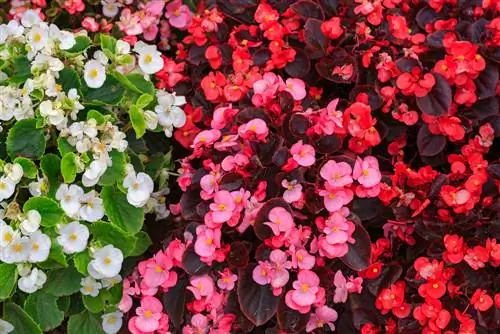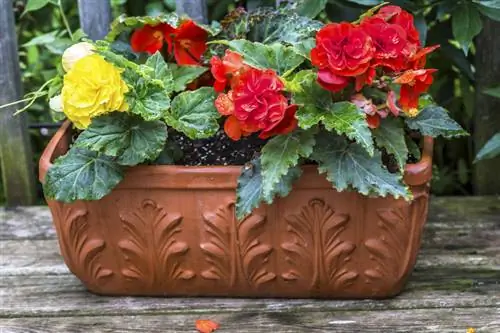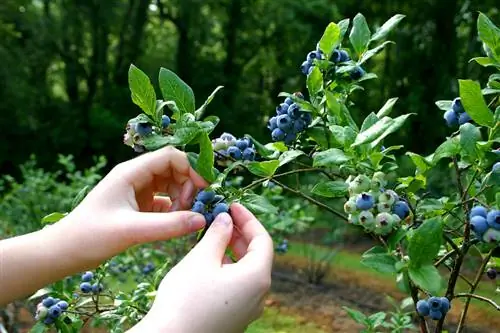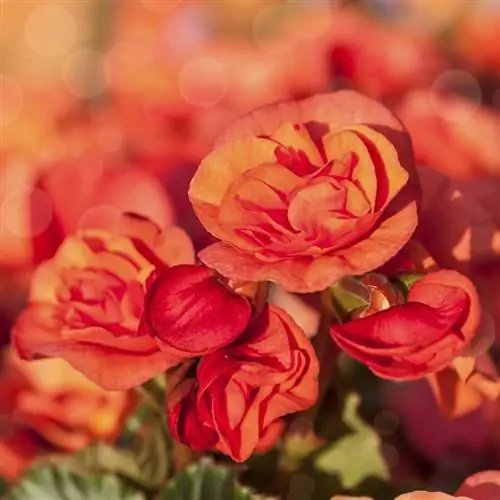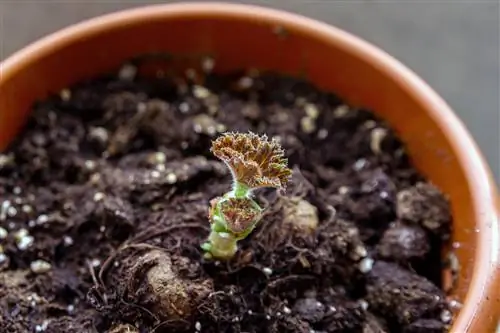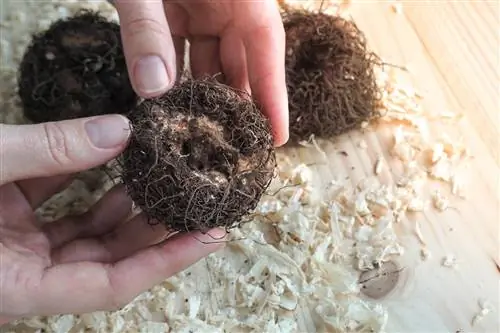- Author admin [email protected].
- Public 2023-12-25 17:45.
- Last modified 2025-01-23 11:21.
Bugonias live up to their name. Leaves sprout from the thick rhizomes in spring, forming a dense bush. The flowering period begins early. The permanent bloomers delight in the right location and with the right care until autumn.
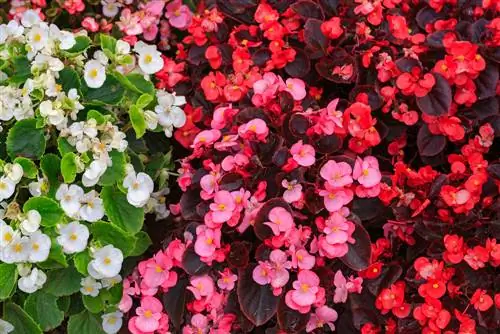
What characteristics and care do tuberous begonias need?
Bugonias are perennial, herbaceous plants that bloom continuously from May to October. They thrive in partial shade and shade, are not hardy and prefer nutrient-rich, loose soil. Dividing rhizomes, growing seeds or sowing seeds is suitable for propagation.
Origin
The genus Begonia within the crooked leaf family includes around 1,400 species worldwide that are native to tropical and subtropical regions of Africa, Asia, South and Central America. Tuberous begonias are cultivated forms of various species of this genus that come from the Andes of Ecuador, Peru and Bolivia. The varieties known as Begonia x tuberhybrida are offered as hanging begonias (Begonia pendula) or scented begonias (Begonia odorata).
Growth
Bugonias grow perennial. They are herbaceous plants that develop an underground rhizome as a survival organ. Their height ranges between 20 and 40 centimeters. There are species whose shoots grow flat, creeping, hanging or towering.
leaves
The foliage of tuberous begonias is asymmetrically shaped. The leaf blade is heart-shaped at the base and extended towards the tip. It has a roughly serrated to toothed leaf edge and a raised midrib from which numerous side veins spread. The laterally branching nerves branch into smaller leaf veins, each of which ends in a tooth on the edge of the leaf. The leaves are dark green, coarse, leathery and fleshy. There are varieties with reddish foliage.
Bloom
Bugonias are unisexual. There are both male and female flowers on one plant, which in their original forms are unfilled. Newer cultivars bear densely double male flowers. In contrast to the semi-double female flowers, where scars are visible in the center, these are not capable of reproduction. The ratio of male and female flowers fluctuates throughout the year depending on the weather. This means that there are times when the plants have different numbers of double and semi-double flowers.
This is how the flowers of wild species are structured:
- same-shaped bracts
- male flowers with two to four petals
- female flowers with two to five petals
Flowering time
The herbaceous ornamental plants prove to be long-term bloomers, whose flowers begin in May and last until October. Some varieties bloom until the first frosts. Tuberous begonias shine in white, yellow and orange, pink or red.
Usage
Bugonias are often grown as annual plants. They decorate flower boxes on north-facing balconies. Pre-grown plants start developing flowers early, making them perfect for the start of the season on the balcony. Varieties with hanging shoots are used for planting hanging baskets. They decorate interiors, terraces or house entrances.
Their rhizomes enable cultivation for several years. This makes the plants attractive for creating flower beds. Due to their location requirements, tuberous begonias are suitable for planting under shrubs and trees. With their splendor of flowers they decorate potted arrangements on roof terraces and can be used for indoor greenery or cultivated in the winter garden.
Which location is suitable?
The Begonia hybrids thrive in partial shade and shady locations. Hours of sunshine in the morning or evening do not affect the plants. They cannot tolerate blazing midday sun as the leaves quickly dry out in the heat of the sun. You should protect the place of growth from wind and rain, as shoots and flowers quickly break off or become damaged.
What soil does the plant need?
The soil should be nutrient-rich and ensure a loose structure so that water can drain off easily. To improve permeability, you can mix some sand into the substrate. Normal potting soil is suitable as a plant substrate.
Propagate tuberous begonias
The simplest propagation method is propagation by division, which is possible in the spring shortly after fresh shoots. Dig up the begonia and cut the tuber into about eight pieces. Make sure that each piece of tuber has an eye so that it can sprout.
For better visibility of the eyes, you can clean the rhizome with a soft brush. If the root has not developed any shoot eyes, it can be stored warm. When it starts to bud, you can cut the sections accordingly. The parts are placed individually in pots with permeable substrate and watered.
You should pay attention to this:
- Clean knives thoroughly before cutting
- Allow tuber pieces to dry after division
- Dust interfaces with charcoal
- pour away excess water from the saucer
Advance
Bugonias can be grown indoors from February onwards so that they start the flowering season early. The rhizomes germinate when the temperatures no longer fall below ten degrees Celsius. They should be stored in lukewarm water for 24 hours before planting so that they swell slightly.
Cover the bottom of a planter with broken pottery, pebbles or expanded clay to prevent water from pooling. Fill the pot three-quarters full with substrate. Place the rhizome on the soil so that the root side with the clearly visible depression is facing upwards. The tubers should only be halfway in the substrate. Lightly moisten the substrate.
Place the pot in a place with temperatures between ten and 15 degrees Celsius. A location in an unheated winter garden or in the basement is ideal. The thermometer should not rise higher, as the fresh shoots develop soft and unstable in locations that are too warm. As soon as the plant has grown about two to four centimeters high and forms its first leaves, you can move the planter to a brighter and warmer place.
Care and further culture
The tuber must not stand in wet substrate. Spray the substrate with water twice a week and make sure that the rhizome does not get any drops of water. A transparent cover prevents drying out. This must be removed daily to prevent mold from forming. The tuber hardly needs any water during rooting. The need increases as soon as the first leaves are visible.
The acclimation phase begins at the end of April. Place the planter outside in a shady place for several hours every day. The temperatures should be at least 15 degrees Celsius. In this way, the tuberous begonia is gradually hardened and adapted to the natural weather conditions. In the evening, bring the plant inside as a precaution so that it is not damaged by late frosts.read more
Sowing
Propagation via seeds requires patience and sensitivity. They are scattered on growing substrate between December and January and lightly moistened. In order for the seeds to germinate, temperatures between 23 and 26 degrees Celsius and high humidity are required. Tuberous begonias are light germinators. Therefore, propagation takes place using seeds under plant lamps. So that the heat does not dry out the substrate. Glass hoods are placed over the planters. Under optimal conditions, the seeds germinate after two to three weeks. The success rate is not particularly high.
As soon as the first shoots are visible, the temperature is reduced to around 20 degrees Celsius. The humidity must also be reduced. Strong sunlight damages the tender shoots and leaves of young plants. It takes up to seven weeks before the plants can be transplanted. Only then is cultivation at around 15 degrees Celsius possible.
Cuttings
Cut a few leaves from a strong plant and put them in a filled planter. A mixture of potting soil and sand is suitable as a substrate. Keep the substrate moist until roots have formed. The cuttings can then be planted individually or in small groups.
What is the best time to plant?
Bugonias are planted out in May when the risk of late frosts has passed. The ice saints serve as a guide for planting. After this appointment you can leave potted plants on the balcony and terrace.
The correct planting distance
When planting in groups, pay attention to the growth width of the respective varieties. Some tuberous begonias grow sprawling. You need a minimum distance of 40 centimeters from your nearest neighbor.
Bugonias in pots
Bulb begonias are ideal for planting balcony boxes, flower pots and hanging baskets. If you place several root tubers in a wide balcony box, you should ensure a distance of 20 centimeters between the plants. This means they are not too close together and can develop he althily.
Watering tuberous begonias
Bugonias do not like waterlogging as it quickly leads to root rot. Any water that collects in the saucer should be poured off immediately. Water the plants sparingly. Short dry periods do not cause them any problems. When watering, make sure that the leaves and flowers do not get any water. It is watered directly on the tuber.
Cut tuberous begonias correctly
Pruning measures are reduced to a minimum for tuberous begonias. It is more important to regularly clean out withered flowers and leaves. This measure supports vitality and stimulates the formation of new flowers. Dead parts of plants rot quickly among the densely growing plants, making them more susceptible to disease. When you take the tubers out of the ground for overwintering, cut off the withered parts of the plant down to a few centimeters.
Fertilize tuberous begonias properly
So that the flowers shine in their full splendor, you can regularly give the plants fertilizer. A liquid fertilizer for balcony plants is ideal. It is added via irrigation water every 14 days. After the flowering period, the fertilizer application is slowly reduced.
Wintering
The ornamental plants are not hardy and die at temperatures just below zero degrees. From the end of September, watering and fertilizing stop completely so that the soil can dry. Remove the tubers from the substrate and clean them with a fine brush. Place the rhizomes in a box filled with sand and place it in a dry, frost-free place with temperatures between five and seven degrees Celsius. The tubers should be stored in a dark place so that they are not encouraged to germinate in winter.read more
Fungal infestation
Under unfavorable conditions, tuberous begonias can be attacked by fungi. When planting, make sure that the tubers are not too close together. Poorly ventilated plant populations increase the risk of fungal infection. A location that is too warm can also cause spores to spread.
Phytophthora
If conditions are too wet, there is a risk that fine roots and rhizomes of tuberous begonias will rot. Fungal spores settle in these places and often survive in the substrate. They penetrate the plant organism with their mycelium and further weaken the plant. As a result, the plant can no longer supply itself with sufficient water and nutrients, so the leaves wither. Infected plants should be removed so that the spores do not spread to other plants.
Powdery mildew
This mushroom is common in gardens and reproduces in dry and warm conditions. It causes a mealy coating on the tops of the leaves that can be easily wiped off by hand. If the fungus spreads its root network further, the leaves brown from the edge to the middle. Thin out infected plants. If the fungus has spread significantly, the entire plant should be removed.
Pests
Weakened plants are more likely to be attacked by pests. You should not over-fertilize the plants and offer them optimal location conditions so that they can develop strongly and he althily. Extracts from plant extracts can support vitality.
Aphids
The pests, which are just a few millimeters in size, overwinter on the plants in the egg stage and hatch in spring. The first generation is formed asexually, so that the plant is occupied by numerous animals within a short time. They suck the plant sap from the veins and leave sticky secretions on the leaves. Spray the plants with a mixture of water and detergent and wipe off the pests with a cloth.
Thrips
These pests leave lesions on the leaves through which air enters the tissue cells. Silvery to white shimmering spots develop in these areas. A heavy pest infestation leads to stunted growth. You can recognize an infestation by brown droppings that accumulate on the leaves. Stunted shoots can be a sign. Spray the leaves with lime-free rainwater and make sure that the air is not too dry. Neem oil has been proven to be a preventive agent.
Bigmouth Weevil
The beetle lays its eggs on the substrate. When the larvae hatch, they burrow into the substrate and feed on the roots. Adult insects eat typical patterns in the leaves. They are active at dusk and at night and will drop from the plant when threatened. Nematodes kill the larvae in the soil while special traps are used to catch the beetles.
Tip
If your tuberous begonia was devastated by a storm, you can plant individual leaves in a pot for rooting. This way you can also grow beautiful plants in late autumn that will bloom on your windowsill for weeks.
Varieties
- Crispa marginata: Blooms from June to November. Flowers bright yellow and pure white with red edges.
- Marmorata: Large-flowered variety. Flowers marbled red and white. Growth height between 15 and 30 centimeters.
- Cascade: Perennial bloomer with hanging shoots. Flowers white. Grows 15 to 30 centimeters high.

